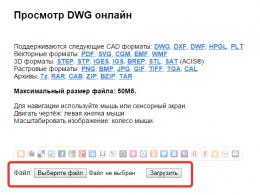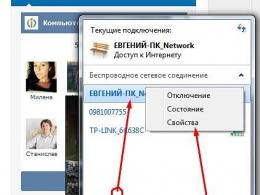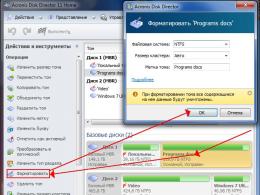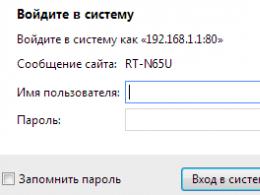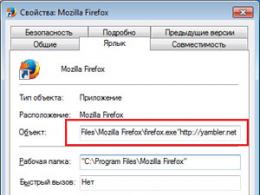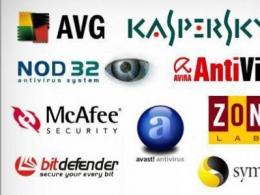What to do if the folder is not deleted. How to delete a file or folder that does not want to be deleted? FileASSASSIN folder remover
If you do not know how to delete a folder that cannot be deleted, then our material will help you figure it out.
Everyone periodically deals with "undeletable" folders on the PC.
It is foolish to blame anyone for this, even the system, which tells us that this directory is currently occupied by some process.
As a result, all liquidation manipulations end in a fiasco. Getting to the main topic: how to delete a folder that is not deleted on (win8)?
There are 5 options for solving the problem:
Let's try to deal with the situation.
Reboot
So, you intend to delete the ill-fated directory, but the system claims that it cannot do this for one reason or another.
The main reason is the use of files in any application or process running at the moment.
The example shows that it is not possible to eliminate the “screenshots” folder, since one or more files are currently being used by one of the Windows programs.
Since most do not know which one, they have no choice but to restart the machine.
Click "Start" (1), then click on the small square (2) near the "shutdown" button. Select the item with reboot (3).
System check
If you do not want to restart, but decide to get to the bottom of the truth, check if the currently running application is in the folder.
Let's say you decide to get rid of Skype for some reason, not only by uninstalling, but by barbaric deletion of the folder in which all the contents of the program are located.
Let's consider this option.
Let's open the folder first. We follow the path: Drive C - Programm Files - Skype.
We see such a picture.

And this is what the system gives out if you press "Delete" on the keyboard.

Firstly, the program is running, so the ability to uninstall is blocked by the system. Secondly, it "hangs" in the task manager, namely in processes.

You need to close the program and, just in case, “kill” the process so that the notification does not appear again.
How to delete a folder that is not deleted from the flash drive? That's right, by pre-checking with an antivirus.
Open the antivirus and scan the drive. Then we try to delete the folder. If it doesn't work, you will have to format the flash drive.
The procedure is the following. Right click on the drive and select Format.

Before us is a menu with settings.

- flash drive capacity;
- File system;
- Volume label (drive name);
- formatting method;
- Starting a process.
The focus is on the file system. FAT 32 should be selected by default. So the contents of the drive can be "read" by any PC.
Any name can be given as it does not affect any parameter.
But for better formatting, it is better to uncheck the “quick cleanup” box. Click "start" and wait.
Folder settings
This technique is good for network directories. In other words, several PCs are combined into a single subnet.
The administrator creates one or more public folders where various information can be dumped. So that no one inadvertently deletes it, it sets access rights.
This is done in the following way. First, open the properties of the folder with the right button.

Go to the "security" section and click "advanced".

We select a group or user to whom we "cut the rights".

Select the group again, and now set the access level.

If you check the boxes for the two items related to deletion, the user over the network will not be able to delete either the folder or its contents.

Consider the example of the same Skype.
Select all the processes that are currently running and click "kill process".

After that, you can easily get rid of the application, since we "killed" it.
In such a simple way, you can clean the system from other programs, applications and folders.
To say that this method is designed for lazy people is impossible. In any case, you will need to know the location where the folder is stored.
On the other hand, all programs are initially installed in the Program Files folder.
How to delete a folder that is not deleted from the desktop and other places on the PC?
Following our advice, you can easily get rid of various software that is stored in directories.
The latter, in turn, can be easily and naturally eliminated.
Important! The system will never "swear" if the list of files in the folder is not currently used anywhere. Whether it's a set of photos, movies or music. If you do not use the file, but for some inexplicable reason you cannot clean your computer, then the contents of the directory are simply infected with a virus. Just in case, scan your system for unwanted software and be careful when downloading something from the Internet.
In all other cases, banal negligence and unwillingness to read the dialog box message, which clearly explains the reason for the impossibility of deleting the folder, is to blame.
How to delete a folder or file that is not deleted? Just!
Answer found! Without any installation programs on the computer!
Due to incorrect work of users or a failure in the process of recording and rewriting documents, locked or damaged folders and files may appear. They take up a certain amount of space on your hard drive, and they cannot be opened, renamed, or deleted.
When you delete locked folders, you receive a system warning that they are not accessible or are being used by another program. There are several ways to try to delete a folder if it is not deleted, depending on the reason for the blocking.
Quick article navigation
Causes
It may not be possible to delete a folder due to a number of reasons:
- Antivirus blocking;
- Lack of administrator rights;
- Use of the folder (or files contained in it) by another program or user of the local network;
- The folder is involved in the system;
- In the settings, the write protection and deletion option is enabled.
Folder settings
Changing the folder settings will help you delete it. This will require:
- Select a folder;
- Right-click to call the context menu;
- Go to the "Properties" section and the "Service" subsection;
- Open the "View" tab;
- Uncheck the box next to "Use simple file sharing" and click "OK";
- Go to the "Security" tab and click on the "Advanced" field;
- Uncheck all checkboxes for reading and execution;
- Confirm the changes with the "OK" button;
- Try deleting the folder.
Restarting the system can help delete the folder (in this case, possible tasks that use the folder, blocking access to it, will be removed). For this you need:
- To restart a computer;
- Try deleting the folder again.
"Safe mode"
If you cannot delete the folder in the normal mode of the operating system, you can try to perform this action in Safe Mode. For this you need:
- Turn on the computer;
- When loading, press the "F8" key several times;
- In the menu that opens, find the section "Additional download options";
- Select the "Safe Mode" item and press the "Enter" button (the system will start in safe mode);
- Find an unnecessary folder and right-click on it;
- Through the context menu, select the "Delete" command and confirm the deletion.
Total Commander
The Total Commander file manager allows you to see hidden and encrypted information in folders that cannot be opened or deleted from Windows. For this you need:
- Download the Total Commander program from the developer's official website (ghisler.com/download.htm);
- In the Total Commander window, find an unnecessary folder in the list of directories and try to delete it through the context menu (or by pressing the "Delete" key);
- If the folder is not deleted, then go into it;
- When a hidden file is found, launch the task manager through the key combination "Ctrl + Shift + Esc";
- Go to the "Processes" tab;
- Find and highlight a hidden file;
- Press the "End Process" button;
- Try to delete the folder through Total Commander again.
Unlocker
The Unlocker program allows you to perform various actions with locked folders (move, rename, merge and delete). This will require:
- Download and install the utility on your computer (emptyloop.com/unlocker/);
- Right-click on the desired folder;
- In the list of the context menu, select the line "Unlocker" (load the program window).
In the upper part, all processes working with an unnecessary folder and its files will be registered. You need to end the processes through:
- "Task Manager" (called by right-clicking on the "Start" panel (not on the button itself, but on an empty space on the panel) and selecting the corresponding item in the list that appears);
- Or in Unlocker itself by clicking on the "Unlock All" button.
Then it remains in the bottom line of the program to select the action "Delete" and confirm the deletion.
You can also try to delete the folder using the section: “Start” -> “Programs” -> “Startup” (if there is any file in the list that is in an unnecessary folder, this means that it is its loading at system startup that prevents the folder from being deleted) or through system restore (if you have previously created a Windows restore point).
If you do not have time to delve into the situation, just restart your computer. In many cases, after restarting, the problematic folder can be deleted in the usual way.
If, when you try to delete Windows, it reports that it cannot find the item to be deleted, the archiver can help you. 7Zip, WinRAR or a similar program will do. Run it and archive the problematic folder, having previously checked the option "Delete files after compression". The program should automatically delete the directory, and you will only have to delete the created archive.
3. Delete the folder via administrator account
The inability to delete a directory may be related to permissions. In such cases, the system requires a password from the administrator account or simply reports the lack of necessary rights. To get around this limitation, you will either have to enter the requested password immediately, or log in as an administrator and only then delete the folder.
Viruses and other malware can also prevent the folder from being deleted. using an antivirus, then try to get rid of the directory again.

5. Check that there are no locked files inside the folder
Often, deleting a folder does not work due to the fact that the files attached to it are used by certain programs. Checking if there is such a conflict is very easy: open the directory, select the internal files and try to delete them. If the system refuses to delete one or more objects, using system tools or third-party programs. Then delete the folder itself.
If the standard explorer refuses to delete the object, try doing it in a third-party file manager. For example, in Total Commander (Windows) or Commander One (macOS).

7. Delete folder in safe mode
If other methods do not help, find the problematic directory and delete it.
It happens that you just need to delete a folder or file, but Windows does not allow you to do this and writes about errors like "this process is busy" or "folder is not empty" or something else. Maybe you found some folder or file that you "didn't like" and want to delete it. Maybe you know for sure that this is "unnecessary trash" that only takes up space, and Windows swears and does not allow it. In general, not so important Why can't you delete, how How to delete and in this article you will find answers to this question.
Most often, such situations occur due to the fact that the deleted files are occupied by other programs. But it also happens that it is impossible to delete a file even after closing all applications that can use this file. For example, a file or folder may become locked due to incorrect user actions and cannot be deleted in any way. These folders (files) remain "hanging" on the hard disk, take up space, are not opened and are not deleted.
The file may not be deleted due to a failure that occurred during its recording or overwriting. If you interrupt the write process, the file is not fully saved, leaving invalid entries in the file system. And our beloved Winda, not knowing how to handle it, simply simply closes access to it, such as for security reasons.
So, let's start dancing with a tambourine!
Why is the file not being deleted?
1) The file was blocked by an antivirus program. Often this happens when the antivirus quarantines the file. Or the antivirus detected a malicious program, but the treatment was delayed (it is waiting for its databases to be updated). In this case, in order to avoid infecting the computer, the user is blocked from accessing this file. Check the quarantine of the antivirus program and delete the file using the antivirus itself, or disable the antivirus and delete the file manually.
2) The file is being used by another program. Think about what programs can use this file. Close them and try deleting the file again. If this does not help, use the Task Manager to check the list of processes, the program may still be running.
3) Administrator rights are required to delete a file. If you are using a user account, log in again as an administrator and try deleting the file.
4) The file is being used by another user on the local network. Please wait and try deleting the file later.
5) The file is in use by the system. Try deleting the file after restarting your computer or in safe mode.
6) The device is write protected. For example, SD memory cards and some USB flash drives have a special switch to lock the device.
There are several ways to remove, I will start with the simplest and most effective and gradually move on to more complex ones.
1. Method:
Reboot
We programmers have a saying - "7 troubles - one reset". What does it mean you can guess
But the meaning of the method is that you need to restart your computer and try to delete the file / folder again.
2. Method:
Safe mode
You need to log in in safe mode.
What is the advantage of booting the system in safe mode? The thing is that Windows does not load its libraries to execute dialogs. To put it simply, if you have a virus on your computer (and this is not excluded), then in this safe mode it will not perform any actions. In this mode, there is nothing superfluous, only a clean AXIS and a person.
In order to enter this mode, when you turn on the computer and after loading the BIOS (or in general, you can press the key intensively from the very beginning of loading the "black screen") F8(no need to press and hold!!!). A black screen will appear, in which you need to select Advanced boot options using the keys on the keyboard, and there is already Safe Mode (well, or just Safe Mode, you don’t need to select all sorts of things there With command line support and so on. And so it will do) and press Enter. If you did everything correctly, the system will boot up and in the lower right corner there will be an inscription Safe mode (it can still be in all corners). Do not be afraid of the black screen that will appear) without wallpaper and beauty.
Now you need to find the file that you just could not delete and try to delete it. In any case (it turned out or not), reboot.
3. Method:
Through the program Unlocker
That's it for such purposes, good uncles wrote such a program, called Unlocker. This is a very small, free program for unlocking files running on Windows. This utility allows you to close open file locks, thus making it possible to perform further actions on these files. Those. the program shows all processes blocking a file (folder) and can delete it despite all blockers.
In addition, the program allows you to rename files and their extensions or move a locked file to another location. This is also very convenient, because. Windows does not always allow you to do this quickly and calmly.
During installation, DO NOT agree to the proposed toolbar (well, or you really need it, then click Next) and uncheck Install Babylon Toolbar - RECOMMENDED. And the rest of the installation is normal - everywhere Further I accept Install and everything)

Just right-click on a file that is not deleted (not moved / renamed) in the usual way and select the program icon from the menu. A window should appear in which you select Delete from the list and press the button OK.

If the file or folder is locked, another window will appear. In it, you must first click on the button Unlock everything, and then Delete.

For those who do not know what bit depth is on the system - we read
4. Method:
Through file managers
Of all the most popular and commonly used file managers, the most popular is Total Commander.
File managers have the ability to bypass some Windows restrictions, which we will use.
To delete a non-removable file, we need to download one of these file managers, FAR or Total Commander (I use Total Commander Podarok Edition). After downloading and installing, find your file in the list of directories and delete it by clicking either the right mouse button and selecting Delete, or the Delete key on the keyboard.
Also, these managers have a good opportunity - to see everything that is hidden and encrypted (especially in different colors, like mine). If you do not delete the folder, then go into it through the manager and see what's there. If you see a hidden file, it means that it interferes. Then launch Task Manager ctrl+shift+esc), go to the Processes tab and look for this file in the list (it’s good to click on the button at the bottom left of the dispatcher Display processes of all users), find and complete (del or RMB -> End process or End process button in the lower right corner). With files, the same application, we are looking for the file name and "kill".
5. Method:
Another option with Unlocker
If the folder is not deleted from you, it writes something like "the folder is not empty", then we create a new folder on the same disk, transfer the folders that cannot be deleted to a new folder, delete the new folder using Unlocker
6. Method:
With autoload
Click Start => Run => In the Run box, type msconfig => Click OK. You will see the System Setup window. Go to the "Startup" tab and in the list of downloaded items, find a name similar to your "non-removable" file.

If there is no such file in the list, then click on the "Disable all" button. Click on the "Apply" => "Close" button. The operating system will issue a warning that all changes made by the system setup program will only take effect after the computer is restarted. Click the "Reboot" button. The computer will restart. After downloading, try deleting the "non-removable" file again.
7. Method:
Using System Restore
In the "System Settings" window (which was the same as in the previous paragraph), select the "General" item. Click on the "Start System Restore" button. In the window that appears, select the item "Restore an earlier state of the computer", click "Next". In a new window, you will see a calendar where you can select the date for system restore. Select a date when the "non-removable" file was not on the computer. Click "Next". Don't worry, System Restore won't affect your personal files.
8. Method:
Lack of permissions to delete files
Right-click on the problematic object and select "Properties" from the drop-down list
In the window that opens, select the "Security" tab
Highlight your name in the list and select "Full Control"
- "Apply" and "OK"
Trying to delete
9. Method:
Use a different operating system.
Try booting from a removable disk (or CD/DVD) (LiveCD or LiveUSB) with a different operating system. Then delete the file/folder.
10. Method:
Move somewhere.
Sometimes it helps to move (cut) the folder to an empty flash drive and format it later.
11. Method:
In the window, type the command chkdsk c: / f / r and click Enter, while keeping in mind that c: is the name of the drive to be checked. If the disk being checked has a different letter, then write it.
If the checked drive is C:, then when you click Enter You will be prompted to check it the next time you reboot. When asked whether to check or not on the next reboot, type Y and press Enter.
If the disk name is different, then the check will start immediately. At the end of the test, the result of the test will appear. Type exit and click Enter.
Now you can delete the file that you didn't want to delete. In the case of drive C, just restart the computer and after checking, delete the non-removable file.
12. Method:
In the case of opening the command line through Start - All Programs ... run the process as an administrator (RMB and Run as Administrator) and move to the folder with the file (or folder) that cannot be deleted using the cd \ command in order to end up in the root directory drive, and then cd folder_name to go to the desired folder.
If you do not know how to delete a folder that cannot be deleted, then our material will help you figure it out.
Everyone periodically deals with "undeletable" folders on the PC.
It is foolish to blame anyone for this, even a system that tells us that this directory is currently occupied by some process.
As a result, all liquidation manipulations end in a fiasco. We are getting to the main topic: how to delete a folder that is not deleted on windows 7 (win8)?
There are 5 options for solving the problem:
Let's try to deal with the situation.
Reboot
So, you intend to delete the ill-fated directory, but the system claims that it cannot do this for one reason or another. The main reason is that the files in the folder are being used by some application or process that is currently running.
The example shows that it is impossible to eliminate the "screenshots" folder, since one or more files are currently being used by one of the Windows programs. Since most do not know which one, they have no choice but to restart the machine.
Click "Start" (1), then click on the small square (2) near the "shutdown" button. Select the item with reboot (3).
System check
If you do not want to restart, but decide to get to the bottom of the truth, check if the currently running application is in the folder.
Let's say you decide to get rid of Skype for some reason, not only by uninstalling, but by barbaric deletion of the folder in which all the contents of the program are located. Let's consider this option.
Let's open the folder first. We follow the path: Drive C - Program Files - Skype.
We see such a picture.
And this is what the system gives out if you press "Delete" on the keyboard.
Firstly, the program is running, so the ability to uninstall is blocked by the system. Secondly, it "hangs" in the task manager, namely in processes.
You need to close the program and, just in case, “kill” the process so that the notification does not appear again.
Exit Skype, then press Ctrl + Alt + Delete (task manager) and select the program. After that, click on the "end the process" button.
A confirmation window will appear. Click again to complete. Now you know how to delete a folder that is not deleted on windows 8 and other OS versions.
Note! The above procedure is equally useful for all such cases, not just for Skype.
Viruses
In some cases, deleting a directory is impossible for the simple reason that potentially unwanted software has penetrated the PC, i.e. viruses. In addition to the Internet, they can get to the computer through a flash drive.
And how to delete a folder that is not deleted from the USB flash drive? That's right, by pre-checking with an antivirus.
Open the antivirus and scan the drive. Then we try to delete the folder. If it doesn't work, you will have to format the flash drive.
Note! Remember, after formatting, all data, folders and files stored on flash memory will be deleted.
The procedure is the following. Right click on the drive and select Format.
Before us is a menu with settings.
- flash drive capacity;
- File system;
- Volume label (drive name);
- formatting method;
- Starting a process.
The focus is on the file system. FAT 32 should be selected by default. So the contents of the drive can be "read" by any PC. Any name can be given as it does not affect any parameter.
But for better formatting, it is better to uncheck the “quick cleanup” box. Click "start" and wait.
Folder settings
This technique is good for network directories. In other words, several PCs are combined into a single subnet. The administrator creates one or more public folders where various information can be dumped. So that no one inadvertently deletes it, it sets access rights.
This is done in the following way. First, open the properties of the folder with the right button.
Go to the "security" section and click "advanced".
We select a group or user to whom we "cut the rights".
Select the group again, and now set the access level.
If you check the boxes for the two items related to deletion, the user over the network will not be able to delete either the folder or its contents.
After that, you can easily get rid of the application, since we "killed" it.
In such a simple way, you can clean the system from other programs, applications and folders.
To say that this method is designed for lazy people is impossible. In any case, you will need to know the location where the folder is stored. On the other hand, all programs are initially installed in the Program Files folder.
How to delete a folder that is not deleted from the desktop and other places on the PC? Following our advice, you can easily get rid of various software that is stored in directories. The latter, in turn, can be easily and naturally eliminated.
Important! The system will never "swear" if the list of files in the folder is not currently used anywhere. Whether it's a set of photos, movies or music. If you do not use the file, but for some inexplicable reason you cannot clean your computer, then the contents of the directory are simply infected with a virus. Just in case, scan your system for unwanted software and be careful when downloading something from the Internet.
In all other cases, banal negligence and unwillingness to read the dialog box message, which clearly explains the reason for the impossibility of deleting the folder, is to blame.

